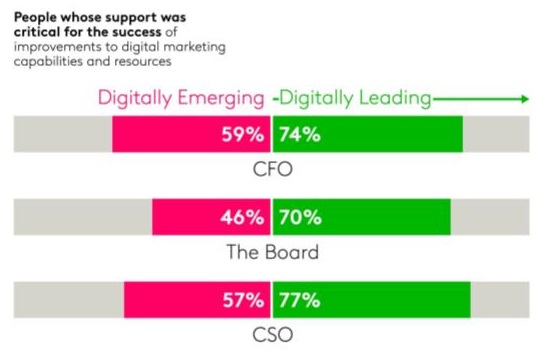Today’s consumers demand omnichannel sophistication and personalized brand experiences, forcing companies to rethink their approach to demand generation and find better ways to measure marketing effectiveness. As these challenges mount, organizations will have to employ new approaches, capabilities and tools that will push the marketing industry from more of an art to a science. As a result, building your digital marketing muscle can no longer be regarded as a cutting-edge task, but the table-stakes for meeting consumer demands and driving operational efficiencies.
Google and Kantar partnered over the summer of 2021 to explore what today’s leading companies do differently to drive revenue growth and digital transformation success. We spoke to 40 Fortune 1000 C-suite members from a range of industries and surveyed 500 senior- to mid-level marketers from large organizations across the United States. Our ambition was to go beyond understanding the presence and investment of tech tools and, instead, identify the organizational drivers of strategy, structure, processes and capabilities that differentiate the digital leaders from the pack.
Driving digital transformation takes more than purchasing and implementing sophisticated technology. Our research found little to no differences in the split between traditional and digital spend in marketing budgets, regardless of a company’s size or digital maturity. True digital transformation, therefore, requires reframing specific organizational characteristics to ensure businesses can deliver on evolving consumer demands and create lasting change.
The companies that are leading the way, or digitally leading companies, view digital transformation as a journey and not a destination. As you might expect, almost all of those we surveyed believe improving their company's digital marketing capabilities and resources is a priority. But putting this into practice is easier said than done. Having the right players – not just enough players – in your digital transformation journey is critical to ensure teams are able to realize immediate gains.
Our survey found that 74% of digitally leading marketers said that teams that were able to produce measurable improvements on a day-to-day basis included a CMO, CDO, head of marketing operations and the chief executive officer. For companies that are not as far along in their digital transformation evolution, or digital emerging companies, that number drops to 53%. The takeaway is that leaders who bring a holistic, process-oriented perspective to transformation efforts fare better than those who juggle a collection of disparate initiatives.

Creating explicit links between where the organization wants to go and how it will get there in the short- and long-term provides teams with clarity on expectations for the transformation over time. But leading an organization through periods of change with a priority of continued improvements requires more than a holistic mindset. Another common barrier to success is that most companies don’t know where to start. Many leaders referenced the importance of setting clear transformation objectives and KPIs to measure success.
We also heard of the importance of complete C-suite alignment on common incentives instead of relying on function-specific goals. While this synergistic approach may seem obvious, many organizations struggle to put this into practice, often citing personality clashes as the key barrier of C-suite alignment. Without a clear vision to unify separate teams, the complexity of managing day-to-day operations and planning in change too often takes precedence over large-scale change programs.
In order to overcome the common barrier of not knowing where to start, organizations must first align on a North Star to fit transformation objectives within the overall business. This breaks the long-term transformation journey into bite-sized pieces and provides teams with a sound foundation for collaboration and growth.
What do digitally leading companies do differently?
Our research uncovered five critical organizational aspects that have had the most influence on success at companies that are leaders in digital marketing. They are:
1. Leadership is committed to prioritizing and protecting digital transformation
We know that in digitally leading companies specific initiatives are led by a C-suite member, but these organizations are also differentiated by their ability to engage a broader array of leadership support. 77% of respondents from digitally leading companies said support from the chief strategy officer was critical, 74% vouched for the CFO’s support and 70% found the Board’s support critical to the success of a transformation initiative. Within digitally emerging companies these numbers dwindle to around half.
The responses reveal that leadership alignment, rather than individual accomplishment, is an incomparable advantage in any large-scale initiative.

This also highlights the importance of uniting the C-suite around common business objectives to overcome the barriers of disparate incentives. The new style of leadership required for the organization of tomorrow is far more about the leadership A-Team than it is about the type-A leader.
Overcoming personality clashes and seeing beyond the individual level can allow for a harmonious effort to achieve digital transformation. It isn’t enough to pick a single CXO to be the ceremonial leader of digital transformation. All C-suite and board members must work together to define which initiatives are critical to deliver on business goals and then appoint a leader most aligned to those initiatives who can lead the steps toward transformation.
While functional capabilities play an important role here, it is also critical that these leaders decide to lean in. They must readily support the CEO's vision and rally their own teams behind the business objectives.
2. Marketing needs to speak the same language as finance
Our research revealed that meeting today’s consumer demands requires greater collaboration between functional leaders, but there are two teams whose alignment is paramount. A collaborative, not transactional, relationship between the CMO and CFO is critical. In fact, 71% of respondents who stated that their most senior marketing person establishes clear financial KPIs for the marketing team cited having a collaborative relationship with their CFO, while only 61% who had a more transactional communication with their CFO were able to create distinct business KPIs.
This presents a new and unique challenge, as historically the language of marketing and the language of finance have been at odds.

Marketers must learn to convey the financial impact of marketing activities on business outcomes to be seen as a legitimate growth lever. Specifically, this means translating marketing metrics into ROI. This is a differentiating element of digitally leading companies.
80% of respondents from the digitally leading companies felt that their approach to measuring marketing effectiveness was accepted by finance; this was true in only 53% from respondents where digital efforts are just starting to emerge. If finance does not understand the business impact of marketing, then marketing will continue to struggle to obtain the resources it needs to move from reporting conflicting marketing outputs to delivering outputs that show how marketing drives business outcomes.
Creating an open channel of communication and prioritizing active learning between the two teams enables both sides to share their expertise and better understand each other’s functions. Facilitating this connection will help the organization value marketing not solely as marcomms experts, but more importantly, as demand generators that ladder directly to better business outcomes.
3. Planning in change requires budgeting in change
Organizations often aspire to adopt agile ways of working but struggle without the proper resources for true organizational agility. Changing course at a moment’s notice requires confident leaders who know when to pivot and have enough financial flexibility to try new things.
The traditional budget planning season allocates spending amounts to initiatives in advance, leaving very little room for in-year changes. In these strict environments, it takes considerable effort to build cases for additional funding, made more difficult by the disparate vocabularies of marketing and finance teams.
Our research revealed that digitally leading companies are differentiated by their proactive approach to reallocate funds for projects throughout the year. Marketers from digitally leading companies are more likely than those who are not to say their budgets are revisited (and if needed, reset) every month or quarter depending on what is needed to meet their objectives. Building this flexibility into the business strategy allows teams to adjust course based on key learnings along the way.
4. Extend collaboration to the right external partners
Digitally leading companies will more likely engage external partners to fill gaps in digital marketing capabilities, while digitally emerging companies adopt a much more DIY mindset. Although many companies see the cost of external partners as a financial burden, digitally leading companies are more likely to embrace it as an investment in their own operational efficiencies.
64% of respondents from digitally leading companies said that they either outsource completely or have equal internal and external responsibilities for managing marketing campaigns, developing creative for digital or determining the ROI of a campaign. In comparison, only 46% of respondents from digitally emerging companies outsourced any digital marketing work.
By outsourcing more of the complex capabilities, digitally leading companies can focus on executing against objectives without the burden of working alone. This reallocation of time and energy can bring relief to pressured team members.
In response to digital marketing initiatives, 89% of respondents from digitally leading companies felt relieved that giving a larger role to digital tools will free up time to focus on different priorities; and 75% from digitally emerging companies agreed.
High endorsement from both poles reinforces the insight that the benefits of digital transformation efforts – and sharing the load of those efforts with other partners – can positively impact employee experience and efficiencies, as well as business outcomes.
5. Culture eats digital transformation for breakfast
To extend Peter Drucker's astute claim beyond just strategy, we found that organizational culture is also imperative to digital transformation. Organizations can purchase the most sophisticated tech, set visionary strategies, and hire for exceptional capabilities, but their internal culture can still hold them back. Team culture must support new levels of cross-collaboration and experimentation.
One of the most cited capabilities to come through our C-suite interviews was the need embrace the ability to operate in change. Readiness to adopt new strategies, test new processes, and evolve team structures will lead organizations to growth, even in ambiguity.
This critical culture change must start at the top with leaders who exemplify an open-minded approach to their roles and responsibilities. 80% of respondents from digitally leading companies said that their marketing leader embraces change, and 70% stated their organization has a culture that is open to experimentation. This compares to only 64% and 47% for respondents from digitally emerging organizations, respectively.
Conclusion
Beyond investing in technology and tools, successful transformation depends on people, on collaborative and visionary leaders, on responsible and diligent cross-functional relations at every level and on partnerships across functions and outside the company. Digital transformation is not about reaching a destination, it’s about constant improvement against these elements that drive the evolution of an organization.
Our data show that even digitally leading companies have work to do in many of these critical areas, leaving more valuable opportunities for organizations at any level to grow. With a firm grasp on the ambition, what does it take to win and build digital maturity? Of the respondents, only 14% worked for digitally leading companies, revealing just how many organizations are stuck in the middle ground. The call for marketers is clear: shift your strategy, structure, processes, and capabilities – and build a culture to support that change – to better meet the needs of today’s shifting landscape.


